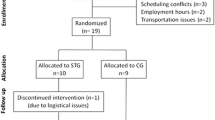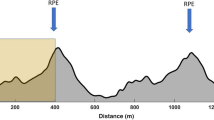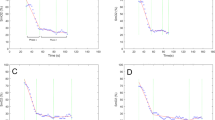Abstract
The purpose was to compare self-chosen pace during ten repetitions of 60 m running sprints performed on a level surface (SPL), or when running uphill (SPU) or downhill (SPD) on a 4.7% slope. When expressed as percent of maximal running speed for corresponding condition, SPD was lower than SPL (95.28 ± 1.93 vs. 97.31 ± 1.29%; P = 0.044), which was lower than SPU (97.31 ± 1.29 vs. 98.09 ± 0.74%; P = 0.026). Heart rates, blood lactate concentrations and general perceived exertion were lower during SPD (163.8 ± 8.3 bpm, 11.66 ± 1.24 mmol L−1, and 4.1 ± 1.0) than SPL (169.8 ± 7.8 bpm, 13.69 ± 0.33 mmol L−1, and 5.8 ± 0.6), which were lower than SPU (174.9 ± 8.7 bpm, 15.27 ± 0.02, mmol L−1, and 6.3 ± 0.5) (P < 0.05 for all analyzes). Results show that the level of eccentric muscle loading influences the pacing strategy.




Similar content being viewed by others
References
Armstrong RB, Ogilvie RW, Schwane JA (1983) Eccentric exercise-induced injury to rat skeletal muscle. J Appl Physiol 54:80–93
Baron B, Dekerle J, Depretz S et al (2005) Self selected speed and maximal lactate steady state speed in swimming. J Sports Med Phys Fitness 45:1–6
Baron B, Noakes TD, Dekerle J et al (2008) Why does exercise terminate at the maximal lactate steady state intensity? Br J Sports Med 42:528–533
Borg G, Ljunggren G, Ceci R (1985) The increase of perceived exertion, aches and pain in the legs, heart rate and blood lactate during exercise on a bicycle ergometer. Eur J Appl Physiol Occup Physiol 54:343–349. doi:10.1007/BF02337176
Buckley JP, Sim J, Eston RG et al (2004) Reliability and validity of measures taken during the Chester step test to predict aerobic power and to prescribe aerobic exercise. Br J Sports Med 38:197–205. doi:10.1136/bjsm.2003.005389
Chelly SM, Denis C (2001) Leg power and hopping stiffness: relationship with sprint running performance. Med Sci Sports Exerc 33:326–333. doi:10.1097/00005768-200102000-00024
di Prampero PE (1986) The energy cost of human locomotion on land and in water. Int J Sports Med 7:55–72
Eston RG, Williams JG (1988) Reliability of ratings of perceived effort regulation of exercise intensity. Br J Sports Med 22:153–155
Foster C, De Koning JJ, Hettinga F et al (2003) Pattern of energy expenditure during simulated competition. Med Sci Sports Exerc 35:826–831. doi:10.1249/01.MSS.0000065001.17658.68
Hampson DB, St Clair Gibson A, Lambert MI et al (2001) The influence of sensory cues on the perception of exertion during exercise and central regulation of exercise performance. Sports Med 31:935–952. doi:10.2165/00007256-200131130-00004
Hampson DB, St Clair Gibson A, Lambert MI et al (2004) Deception and perceived exertion during high-intensity running bouts. Percept Mot Skills 98:1027–1038. doi:10.2466/PMS.98.3.1027-1038
Hettinga FJ, De Koning JJ, Broersen FT et al (2006) Pacing strategy and the occurrence of fatigue in 4000-m cycling time trials. Med Sci Sports Exerc 38:1484–1491. doi:10.1249/01.mss.0000228956.75344.91
Hunter AM, St Clair Gibson A, Mbambo Z et al (2002) The effects of heat stress on neuromuscular activity during endurance exercise. Pflugers Arch 444:738–743. doi:10.1007/s00424-002-0841-x
Lambert EV, St Clair Gibson A, Noakes TD (2005) Complex systems model of fatigue: integrative homoeostatic control of peripheral physiological systems during exercise in humans. Br J Sports Med 39:52–62. doi:10.1136/bjsm.2003.011247
Leger L, Boucher R (1980) An indirect continuous running multistage field test: the Universite de Montreal track test. Can J Appl Sport Sci 5:77–84
Lindstedt SL, LaStayo PC, Reich TE (2001) When active muscles lengthen: properties and consequences of eccentric contractions. News Physiol Sci 16:256–261
Marcora SM (2008) Do we really need a central governor to explain brain regulation of exercise performance? Eur J Appl Physiol
Mizrahi J, Verbitsky O, Isakov E (2000) Shock accelerations and attenuation in downhill and level running. Clin Biomech (Bristol, Avon) 15:15–20. doi:10.1016/S0268-0033(99)00033-9
Noakes TD (2007) The central governor model of exercise regulation applied to the marathon. Sports Med 37:374–377. doi:10.2165/00007256-200737040-00026
Noakes TD, St Clair Gibson A (2004) Logical limitations to the “catastrophe” models of fatigue during exercise in humans. Br J Sports Med 38:648–649. doi:10.1136/bjsm.2003.009761
Noakes TD, Peltonen JE, Rusko HK (2001) Evidence that a central governor regulates exercise performance during acute hypoxia and hyperoxia. J Exp Biol 204:3225–3234
Noakes TD, St Clair Gibson A, Lambert EV (2004) From catastrophe to complexity: a novel model of integrative central neural regulation of effort and fatigue during exercise in humans. Br J Sports Med 38:511–514. doi:10.1136/bjsm.2003.009860
Noakes TD, St Clair Gibson A, Lambert EV (2005) From catastrophe to complexity: a novel model of integrative central neural regulation of effort and fatigue during exercise in humans: summary and conclusions. Br J Sports Med 39:120–124. doi:10.1136/bjsm.2003.010330
Peake J, Nosaka K, Suzuki K (2005) Characterization of inflammatory responses to eccentric exercise in humans. Exerc Immunol Rev 11:64–85
Perrey S, Betik A, Candau R et al (2001) Comparison of oxygen uptake kinetics during concentric and eccentric cycle exercise. J Appl Physiol 91:2135–2142
Schwane JA, Armstrong RB (1983) Effect of training on skeletal muscle injury from downhill running in rats. J Appl Physiol 55:969–975
Smith LL (1991) Acute inflammation: the underlying mechanism in delayed onset muscle soreness? Med Sci Sports Exerc 23:542–551
Tucker R, Bester A, Lambert EV et al (2006) Non-random fluctuations in power output during self-paced exercise. Br J Sports Med 40:912–917. doi:10.1136/bjsm.2006.026435 discussion 917
Ulmer HV (1996) Concept of an extracellular regulation of muscular metabolic rate during heavy exercise in humans by psychophysiological feedback. Experientia 52:416–420. doi:10.1007/BF01919309
Wright R (1996) Brehm’s theory of motivation as model of effort and cardiovascular reponse.In: Gollwitzer PM, Bargh JA (eds) Guilford, New york
Young W, McLean B, Ardagna J (1995) Relationship between strength qualities and sprinting performance. J Sports Med Phys Fitness 35:13–19
Zamparo P, Perini R, Peano C et al (2001) The self selected speed of running in recreational long distance runners. Int J Sports Med 22:598–604. doi:10.1055/s-2001-18559
Author information
Authors and Affiliations
Corresponding author
Rights and permissions
About this article
Cite this article
Baron, B., Deruelle, F., Moullan, F. et al. The eccentric muscle loading influences the pacing strategies during repeated downhill sprint intervals. Eur J Appl Physiol 105, 749–757 (2009). https://doi.org/10.1007/s00421-008-0957-6
Accepted:
Published:
Issue Date:
DOI: https://doi.org/10.1007/s00421-008-0957-6




